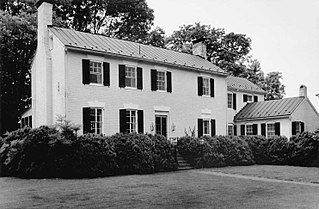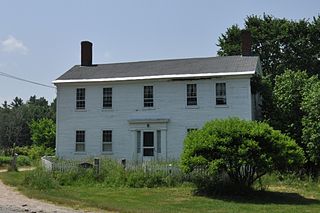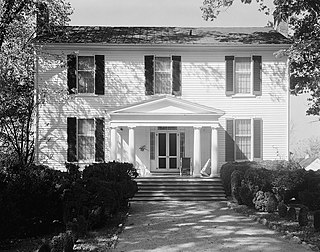
Springfield is a historic neighborhood of Jacksonville, Florida, United States, located to the north of downtown. Established in 1869, it experienced its greatest growth from the early 1880s through the 1920s. The Springfield Historic District is listed in the National Register of Historic Places, and contains some of the city's best examples of 19th and early 20th century architecture.

The La Grange Historic District is a national historic district located in La Grange, North Carolina, United States. The district, originally encompassing 225 buildings and 1 structure, includes the historic commercial, residential, and industrial center of La Grange. The buildings include notable examples of Gothic Revival, Queen Anne and Bungalow/American Craftsman styles of architecture and date between the 1850s and the 1940s. Located in the district is the separately listed La Grange Presbyterian Church. Other notable buildings include the Sutton-Kinsey House, Walter Pace House, Sutton-Fields House, Colonel A. C. Davis House (1887), and the Rouse Banking Company Building (1908). The historic district was added to the National Register of Historic Places in May 2000.

Roxboro Male Academy and Methodist Parsonage is a historic school and church parsonage located at 315 N. Main Street in Roxboro, Person County, North Carolina. The original main block was built between 1840 and 1854, as a two-story, single-pile, frame building with Greek Revival style design elements. A two-story addition with Italianate style design elements was added in the late-19th century. The house took on some Colonial Revival style design elements with the addition of a front porch and interior changes in that style. It is one of the oldest buildings still standing in the town of Roxboro and served as a Methodist parsonage from 1854 to 1915.

The Main–Market Historic District is a historic district located in Akron, Ohio. It was added to the National Register of Historic Places in 2003.

Hare Forest Farm is a historic home and farm complex located near Orange, Orange County, Virginia, United States. The main house was built in three sections starting about 1815. It consists of a two-story, four-bay, brick center block in the Federal style, a two-story brick dining room wing which dates from the early 20th century, and a mid-20th-century brick kitchen wing. Also on the property are the contributing stone garage, a 19th-century frame smokehouse with attached barn, an early-20th-century frame barn, a vacant early-20th-century tenant house, a stone tower, an early-20th-century frame tenant house, an abandoned storage house, as well as the stone foundations of three dwellings of undetermined date. The land was once owned by William Strother, maternal grandfather of Zachary Taylor, and it has often been claimed that the future president was born on the property.

The Todd Block is a historic commercial and civic building at 27-31 Main Street in Hinsdale, New Hampshire. It consists of two separate buildings that were conjoined in 1895, creating an architecturally diverse structure. The front portion of the building is a 2+1⁄2-story wood-frame structure with Second Empire styling; it is only one of two commercial buildings built in that style in the town, and the only one still standing. It was built in 1862, and originally housed shops on the ground floor and residential apartments above. The front of the block has a full two-story porch, with turned posts, decorative brackets and frieze moulding. The corners of the building are pilastered, and the mansard roof is pierced by numerous pedimented dormers. The rear section of the building was built in 1895 as a hall for the local chapter of the Independent Order of Odd Fellows (IOOF). The principal feature of this three-story structure is its east facade, which has a richly decorated two-story Queen Anne porch.
L. Banks Holt House is a historic home located near Alamance, Alamance County, North Carolina. It was built in the 1870s, and consists of a two-story main block, two-story ell, and one-story hip-roofed wing in a vernacular Italianate style. Parts of the house may date to the late 18th or early 19th century. Also on the property is the Holt family cemetery.

The Plummer Homestead is a historic house museum at 1273 White Mountain Highway in Milton, New Hampshire. Built in the 1810s and repeatedly extended, it dates to the early settlement period of Milton, and is, along with the adjacent Plumer-Jones Farm, one of the oldest farm properties in the state. Both are now part of the New Hampshire Farm Museum. The house was listed on the National Register of Historic Places in 2002.

Melrose, also known as the Williamson House, is a historic plantation house located near Yanceyville, Caswell County, North Carolina. It consists of two two-story, frame blocks connected by a 1+1⁄2-story breezeway. The original section dated to about 1780 and is a two-story, frame single pile block with Federal style details. The later section was built about 1840, and is a two-story, frame single pile block with Greek Revival style details. The later section features a portico supported by four unfluted Doric order columns. Also on the property is an octagonal, Williamsburg-style pump house with a conical roof.

Claremont High School Historic District is a national historic district located at Hickory, Catawba County, North Carolina. The district encompasses 172 contributing buildings and 3 contributing structures in a predominantly residential section of Hickory. Most of the dwellings date from the late 19th through mid-20th century and include notable examples of Queen Anne, Colonial Revival, Tudor Revival, and Bungalow / American Craftsman style architecture. The Claremont High School was completed in 1925, and is a three-story, H-shaped, Neoclassical style school. The school was rehabilitated in 1986 as an arts and science center. Other notable buildings include Maple Grove, Shuler-Harper House (1887), Harvey E. McComb House (1889), (former) Corinth Reformed Church Parsonage (1895), Shuford L. Whitener House, Judge W. B. Councill House (1902), George W. Hall House, Carolina Park, Josephine Lyerly House, John L. Riddle House (1918), Marshall R. Wagner House (1938), David M. McComb Jr. House (1939), Arthur H. Burgess House (1940), and R. L. Noblin House (1950).
Cool Springs was a historic home located near Carvers Creek, Cumberland County, North Carolina. It consisted of two sections: a 1+1⁄2-story Federal style coastal cottage form section dated to about 1815-1820 and a two-story, Greek Revival style section dated to about 1825–1830. Also on the property are the contributing barn; a late-19th century storage building; a mid-19th century one-story house, said to have been a school; and a spring house. The house has been demolished.
Beallmont, also known as the Moore-Beall House, is a historic home located near Linwood, Davidson County, North Carolina. The main section dates to the late-18th or early-19th century, and is a two-story, Federal style frame dwelling. It has later additions of a one-story front porch, a two-story rear wing, and a one-story east side wing. The house was remodeled about 1840 in an approximation of Andrew Jackson Downing's "cottage" style.

The Dempsey Wood House is a historic home located near Kinston, North Carolina, United States. Built in the mid-19th century, the house exemplifies the transition from Greek Revival to Victorian architecture. Interesting architectural details of the home include the two-story porch and eight fireplaces. The Dempsey Wood House was added to the National Register of Historic Places (NRHP) in 1971.

Freeman House, also known as The Stateline House, is a historic home located on the North Carolina-Virginia state line near Gates, Gates County, North Carolina, USA. The house was built in three building phases, the earliest perhaps dating to the late-18th century. The farmhouse was initially built following the basic early-Federal-style one-room plan, followed by the addition of a late-Federal-style two-story side-hall-plan, which was finally enlarged and converted in the mid-19th century to a more substantial Greek Revival style, center-hall-plan dwelling. The main section is a two-story, five-bay, frame structure. Also on the property are the contributing smokehouse, a kitchen with exterior end chimney, a one-story tack house with an attached wood shed, a small, unidentified shed, two large barns, and a stable.

Oxford Historic District is a national historic district located at Oxford, Granville County, North Carolina. The district encompasses 201 contributing buildings, 1 contributing site, and 2 contributing objects in the central business district and surrounding residential sections of Oxford. It includes buildings dating from the early-19th century through the 1930s and notable examples of Greek Revival and Late Victorian style architecture. Located in the district is the separately listed Granville County Courthouse (1838-1840). Other notable buildings include the Bryant-Kingsbury House, Taylor-McClanahan-Smith House (1820s), former Granville County Jail, Oxford Women's Club, Titus Grandy House (1850s), Oxford Presbyterian Church, St. John's College, Lyon-Winston Building (1911), Herndon Block Number 2, Hunt Building, L. H. Currin-American Tobacco Company (1860s), and St. Stephens Episcopal Church (1902).

Bingham School is a historic school complex located at Oaks, Orange County, North Carolina. The complex includes a large, expansive, multi-stage headmaster's house, a contemporary smokehouse and well house. The oldest section of the house is a log structure that forms the rear ell and dates to the early 19th century. Attached to it is a frame addition. The front section of the house, is a two-story Greek Revival style, three bay by two bay, frame block dated to about 1845. The rear of the house features a colonnaded porch with Doric order columns that carries along the rear of the two-story section and the front of the ell. The school operated at this location from about 1845 to near the end of the American Civil War.

Holloway-Walker-Dollarhite House is a historic home located near Bethel Hill, Person County, North Carolina. It consists of a 1+1⁄2-story block with a shed addition and Georgian details dated to the late-18th century; a two-story, mid-19th century central block with Greek Revival style trim; and a 1+1⁄2-story, early-19th century section moved to the property in 1976. The early-19th century section is connected to the main block by a modern addition.

Green River Plantation is a historic plantation house on over 360 acres located near Columbus, Polk County, North Carolina. The oldest section of the "Big House" was built between the years 1804–1807, and is a two-story, four-bay, Late Federal style frame dwelling. A later two-story, four-bay, brick Greek Revival style dwelling was built beside the original structure in the mid-19th century. The two sections were joined in the late 19th century by a two-story section and grand staircase to form a structure that is over 10,000 square feet in size and boasts over 42 rooms and spaces. The plantation house was built by Joseph McDowell Carson, son of Col. John Carson, who built Carson House at Marion, North Carolina. The later-built section of the home was the residence of Samuel Price Carson, North Carolina State Senator and U.S. Federal Representative, and younger brother of Joseph McDowell Carson.

Ashland is a historic plantation house located near Henderson, Vance County, North Carolina. It consists of two sections dated to the late-18th and mid-19th centuries. The older section is a two-story, two-bay, frame section attached to the newer and taller two-story, three-bay frame section. Each section is sheathed in weatherboard and topped by gable roofs. The house displays elements of Federal and Greek Revival style architecture. Judge and colonizer Richard Henderson (1734–1785) owned the Ashland tract among his vast holdings.

The Solomon Goodrich Homestead is a historic house at 4787 Ethan Allen Highway in Georgia, Vermont. With its oldest section dating to the late 1780s, it is one of the community's oldest surviving buildings. Its later and more prominent brick front is a good early example of Federal period architecture. The house was listed on the National Register of Historic Places in 2004.





















